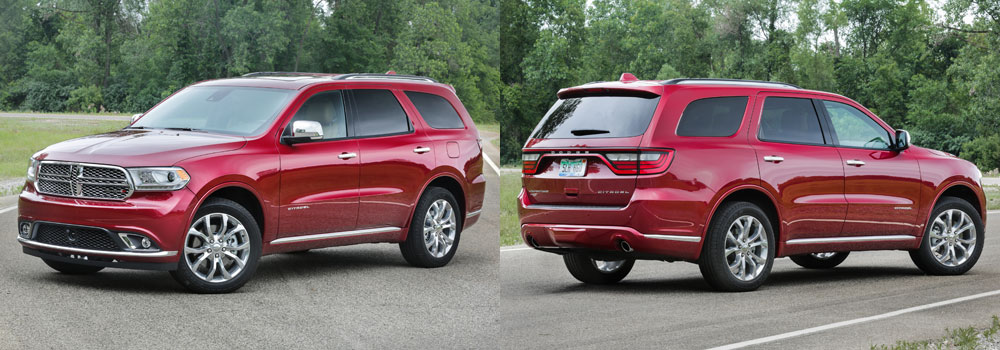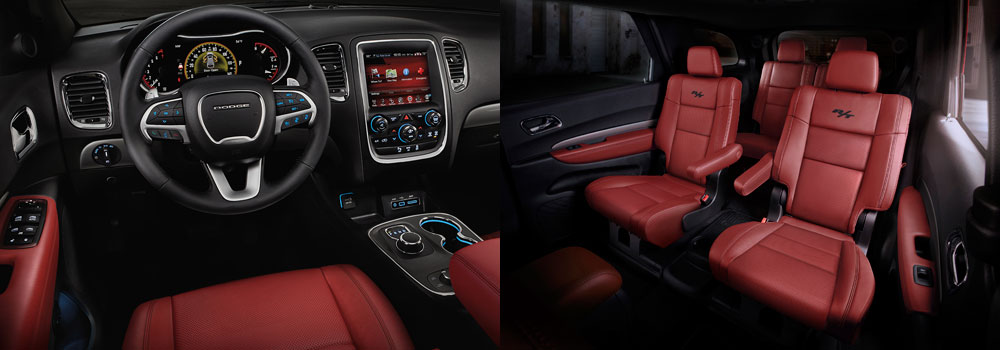Dodge Durango is a near full-size crossover SUV with seating for up to seven passengers. It's a trifle larger than midsize three-row crossovers like the Ford Explorer, Honda Pilot or Toyota Highlander, but decidedly smaller than full-sizers like the Chevrolet Tahoe and Ford Expedition. With roughly the same wheelbase and overall length, the Chevrolet Traverse is most similar size-wise. Unlike the front- or all-wheel-drive Traverse, Durango is offered in rear- or all-wheel-drive.
Durango is available in one of four trim levels: SXT, Limited, Citadel and R/T. All, save the R/T, come standard with a 3.6-liter V6 that makes 290 horsepower. Standard on the R/T and optional on the Citadel is a 5.7-liter V8 that packs 360 horsepower. Both engines pair with an 8-speed automatic.
Rear-wheel drive is standard across the board. Optional on the V6 is an all-wheel-drive (AWD) system that's fine for everyday driving in the rain and snow. V8s are available with a more rugged AWD system that boasts a 2-speed transfer case for low-speed slogging. V6 models have a 6200-pound towing capacity, while V8 models can tow up to 7400 pounds.
Standard safety features include antilock disc brakes, stability and traction control, trailer sway control, front-side, driver-knee airbag and full-length side-curtain airbags. A rearview camera and parking sensors are optional on the SXT and standard on others. Also available are blind-spot warning, rear cross-path alert, and forward collision warning.

All models come standard with 7-passenger seating on front buckets, a 3-place second-row bench and a 2-passenger third-row bench. Available are second-row captain's chairs that reduce overall seating capacity to six. Prices start as low as $30,495 for a 2-wheel-drive SXT and climb to $41,295 for the R/T. Durangos have a $995 destination charge and are assembled in Detroit, Michigan.
Durango's base 3.6-liter V6 provides adequate acceleration and no more. It's relatively smooth and mates seamlessly to the slick-shifting 8-speed automatic. Expect to make an unloaded run from 0 to 60 mph in about 8 seconds. That's about par for the course in the class.
Those wanting more power or spending a lot of time towing or hauling should certainly consider the available 5.7-liter V8. Not only does the 0 to 60 mph time drop to about 6 seconds, but towing capacity goes up and passing punch is greatly improved. Like the V6, the V8 is also refined but boasts a sporty exhaust growl that might not be to everyone's liking.
As you might expect, fuel economy is only mediocre. The V6 AWD model nets EPA number of 18/22 mpg city/highway. The V8 numbers drop to 14/22 mpg. Both engines have fuel saving features. The V6 gets start/stop and the V8 gets variable displacement. Real-world numbers with either engine don't vary much from the EPA estimates and Dodge states that the V8 runs best on slightly-more-expensive mid-grade fuel.
The AWD system that comes with the V6 is generally fine for all-season use, but it is not intended for severe off-road driving and can overheat in extended slippery-road situations. The AWD system that comes with the V8 is significantly more robust and sports a 2-speed transfer case. As a result, it handles off-road situations much more competently.
Durango is a large and heavy vehicle. Accordingly, it's not as nimble or car-like to drive as some slightly smaller competitors. Still, it's weight works to its advantage when it comes to ride quality. There is a smoothness and compliance over bumps that isn't found on most competitors and Durango takes a stable and sure-footed track through turns and on ramps. The steering is somewhat slow around town but has good on-center feel on the highway. Brakes are strong, providing ample stopping power.

Inside, Durango is a model of modern efficiency. The interior is smartly arranged and nicely fitted with lots of soft-touch plastics and just enough bright highlights to keep it from becoming austere. Front seats are generously padded and offer great head and leg room. The step up can be a big one, but once in place, drivers have a commanding view of the road and good visibility aft.
Bench or captain's chairs, second-row seats are quite accommodating and offer good leg room and plenty of head room. Third-road seats are best left to children, although adults will find a modicum of comfort on short trips. Thankfully, getting in and out is a snap because of wide-opening doors and an easy tilt-and-slide second-row seat.
From Bluetooth to Wi-Fi to an 8.4-inch touchscreen, Durango is packed with the latest connectivity and infotainment technology. The UConnect system is intuitive to operate and quickly lets occupants adjust entertainment, navigation and climate settings through the large touchscreen. It's a model of efficiency that other automakers could copy. Unfortunately, it does not offer support for Android Auto or Apple Car Play.
Second- and third-row seats folded, cargo space is a generous 84.5 cubic feet. That's on par with others in the class. Even with the second-row seats in place, there's still nearly 50 cubic feet of space. All seats in place, there enough room for a couple of golf bags or a week's worth of grocery bags. Interior storage abounds with lots of open and covered bins.
Overall, Durango makes a very compelling argument for large crossover shoppers' attention. It's got a great mix of comfort, convenience and utility. It's on the brawny side, though, and that's sometimes an advantage, think towing and hauling, and sometimes a disadvantage, think fuel economy and low-speed maneuverability. With fair pricing and attractive incentives, Durango remains extremely competitive in this very competitive segment.
|
|